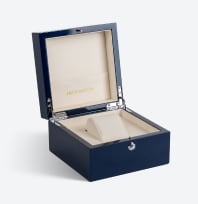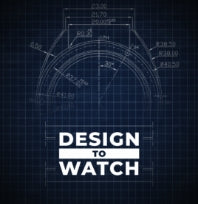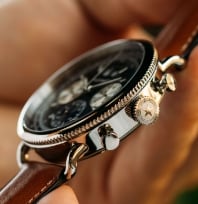To understand quartz watches, we need to first understand the standard ways in which watches are powered. There are three main types of movements, or energy types, used in watches on the market today:
- Mechanical
- Automatic
- Quartz or Solar Quartz
Mechanical Watches
Mechanical watches are the kingpin of the watch world. Mechanical watches have been around since the beginning of watches. In over a century of modifications and technological advancements, the most significant difference in a mechanical watch besides the individual watch design themselves is that mechanical watches now use a built-in crown, instead of a tiny key to wind the inner mainspring. Mechanical watches are hand-wound timepieces that use a complex movement composed of hundreds of small parts that work together in harmony to make a mechanical watch tick.
Automatic Watches
While automatic movements are technically an older technology than quartz movements, they are still among the most common movements in watches because they exude a different degree of quality, craftsmanship, and complexity. Instead of batteries, they run off of the energy from a wound spring. This mainspring stores energy and distributes it through interconnected gears and other springs controlling the energy supply to power the watch. The mainspring is “charged” either through winding by hand or the natural motion generated by the wearer’s movement that rotates a tiny rotor back and forth.
While most automatic watches may carry more mechanical complexity and cost significantly more than most quartz watches, they’re also less accurate by nature of the design. While an automatic movement generally has an accuracy of +/-10 seconds to +/- 30 seconds per day, a quartz movement will have this same accuracy range or better over an entire month. For those in the pursuit of ultimate time-keeping precision, a quartz watch will be a clear choice.
Quartz
Once upon a time, quartz was a state-of-the-art technology that almost overturned the entire watchmaking industry. Heading off what is considered the Quartz Revolution or some Quartz Crisis (depending on your feelings), quartz soon showed that the most effective and accurate way to tell time was not through a complex network of gears, but with a simple crystal, battery and tiny motors.
Utilizing this new time-keeping technology was considered unforgivable to some, as it disrupted the status quo of the watch winding world.
Let us not forget that a quartz watch, except for the occasional change of batteries, needs far less service than its mechanical alternative. For a moment, let’s forget that quartz is more accurate at telling time than even the most expensive, most expertly-tuned mechanical watches. Also, unlike mechanical watches, gravity does not affect the inner workings at all, so a quartz watch tells the time just as well when you are deep under the ocean in a submarine as it does when you are climbing the highest mountain. Forget that quartz is more affordable than mechanical watches.
All clocks need an oscillating, regulating element to keep the time accurate. In mechanical clocks and watches, it exists in the form of a balance spring and balance wheel. For a quartz watch, however, there is a tiny quartz crystal cut in the shape of a tuning fork.
Let’s dive even deeper into this mind-blowing nerdiness.
Quartz naturally vibrates at an exact frequency and contains piezoelectric properties, which means that when it is pressurized, it produces a small volt of electricity. The inverse of this is also true, so that when an electric current is passed through quartz, it vibrates, usually at 32,768 times per second.
Most watches with a quartz movement have a guaranteed accuracy at around 15 seconds plus or a month or so. This accuracy is still much better than even the best mechanical watches. The quartz watch’s only enemy? Temperature.
So how do the inner workings of a quartz watch actually work?
- A battery provides the current to the microchip circuit.
- A microchip circuit makes the precisely cut tuning fork quartz crystal vibrate at 32768 times per second.
- Another microchip circuit detects the crystal’s oscillations and turns them into regular electric pulses, one per second.
- These electric pulses drive the miniature electric stepping motor and convert electrical energy into mechanical power.
- The electric stepping motor also turns the tiny gears.
- These tiny gears sweep the hands around the clock face to keep time.
The answer is that the quartz vibrates at a subtly different frequency at different temperatures and pressures. Its time-keeping capability is affected to a small degree by the warming, cooling, ever-changing environment around us. So, in theory, if you keep a watch on your wrist at all times, it is much more or less constant temperature. That watch will keep time better than if you take it on and off your wrist, causing a rather significant temperature shift, in any environment.
The critical thing to remember about quartz is that it’s piezoelectric. It will vibrate when you put electricity to it, and it is going to give you electricity when you vibrate it. The quartz crystal oscillator uses piezoelectricity in both directions — at the same exact time. Making quartz an incredibly efficient power source. Hence why watch batteries actually last quite a long time.
So, in a nutshell, why are quartz watches worth investing in?
What quartz watches lack in finesse and historic footing they excel in the following three areas:
- Practicality
- Size
- Durability
Practicality
The pure practicality of quartz is that these watches have a power reserve that literally lasts for a lifetime. So once you set your watch, you will rarely ever have to touch it again. This Green & Steel Seamount Jack Mason will just keep on trucking along for years to come (and side note it has 300 meters of water resistance). You can forget your quartz watch on the counter, pick it up six months later, and there it is, ticking away ready to be worn immediately.
Size
Size is a HUGE factor. Because of the smaller sized movement, quartz watches can be slimmer and smaller than automatic watches. Smaller watch casings are essential when you have a smaller wrist. Quartz watches tend to sit flatter than a mechanical because their parts don’t take up so much room, which also means they also slide more easily under cuffs and sleeves.
Durability
It’s worth noting that quartz movements are often longer-lasting than mechanical watches. If you work in manual labor or just enjoy the great outdoors and the potential watch hazards that come with it, then a quartz watch is perfect for you.
Check out the Jack Mason Overland watch, designed for durability and is water resistant up to 100 meters. This watch runs off of premium Japanese quartz. Quartz watches like the Overland can take on a higher impact than mechanical and automatic watches because of their effortless simplicity. There is nothing inside the watch that is going to get thrown off-kilter if you bash your watch into something or take a tumble. Which is why some of the most robust watches are quartz movement watches.
In the end, the battle between quartz, mechanical, and automatic watches will be won by the wearer’s preferences and use. Yes, there will always be the folks out there who say the automatic watch is more of an authentic choice. Or that at least automatic watches inherited the integrity of the mechanical watch. But you tell me, how does it get more authentic than an old rock that creates electricity when vibrated at a certain frequency? I mean, that’s super cool. But before quartz came along, watch enthusiasts around the world said some pretty terrible things about automatics too. It takes time, sometimes decades, to get used to new technology in a world that is all about timelessness and that luxury is in the details like the watch industry.
Sources:
https://www.explainthatstuff.com/quartzclockwatch.html
https://www.worthy.com/blog/knowledge-center/watches/best-watch-movements/









